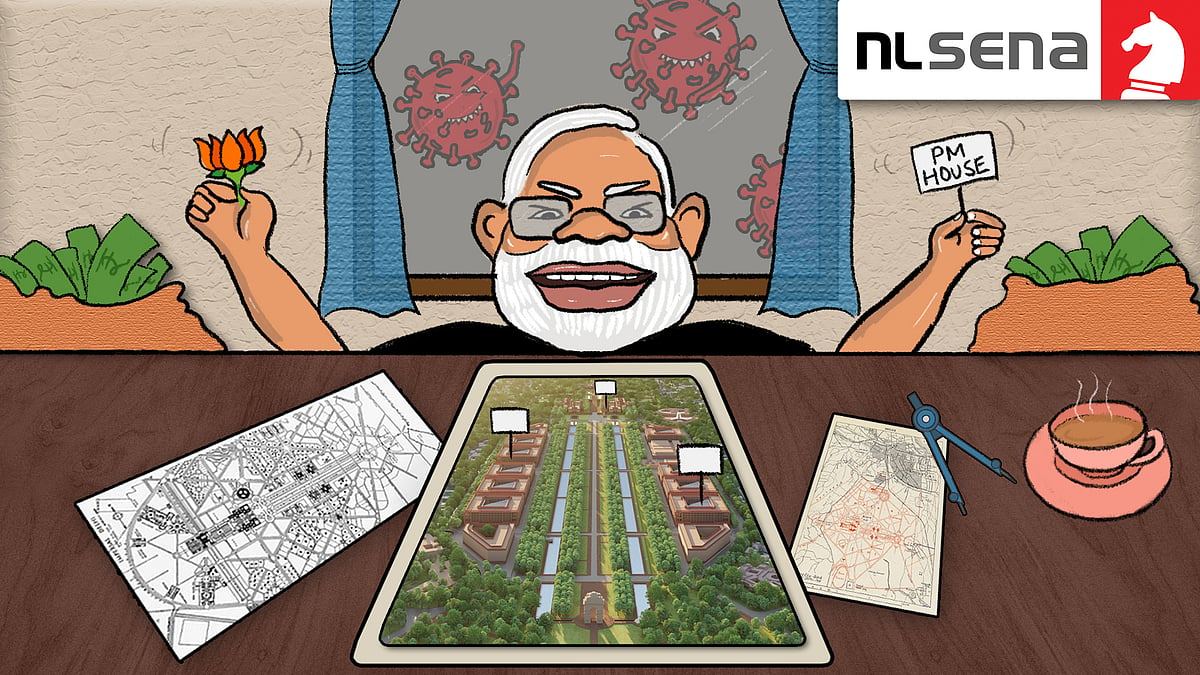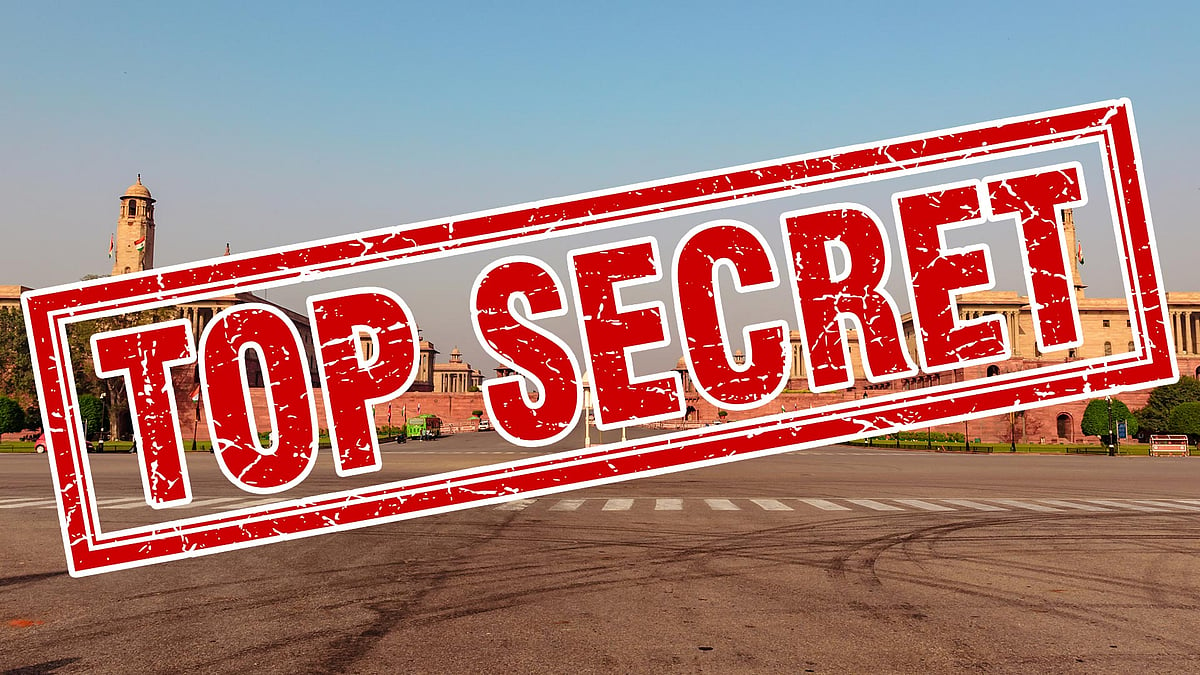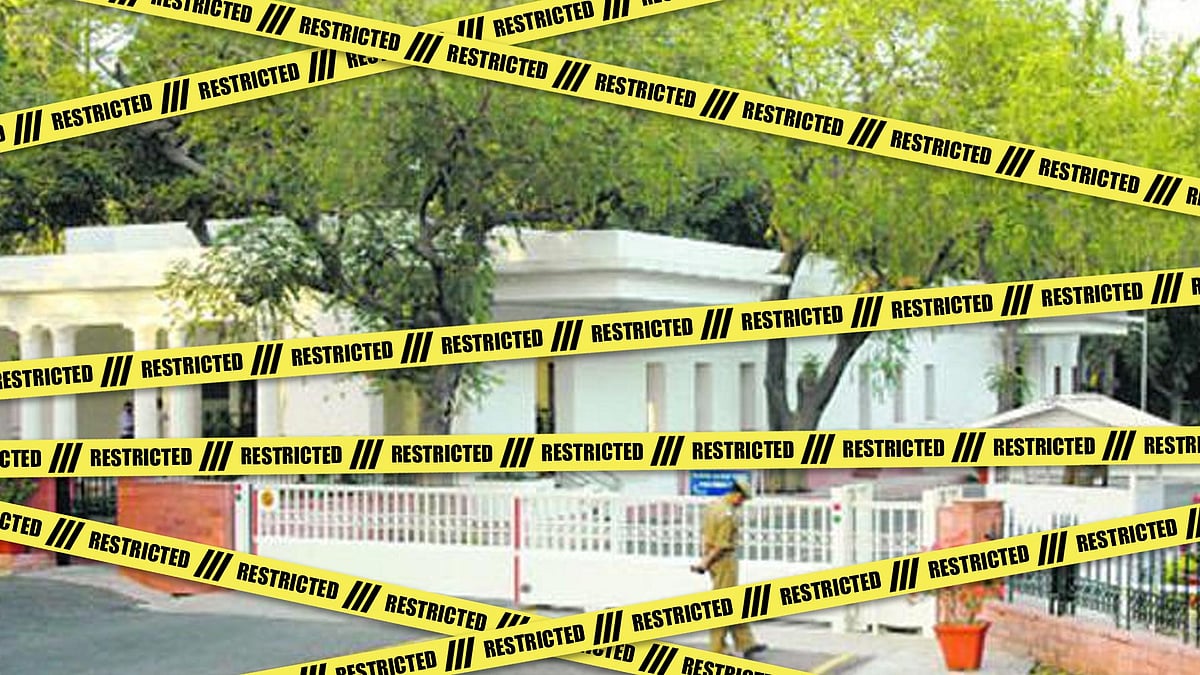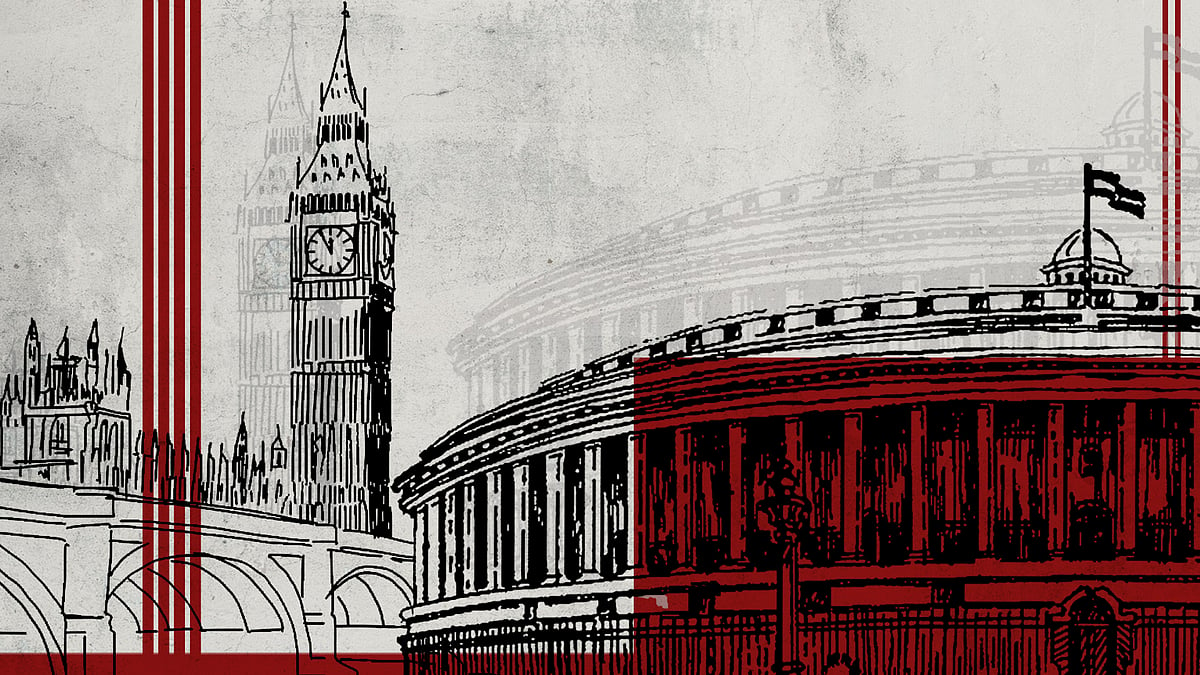Central Vista is an illegitimate monument to deceit
It's been made possible by treating the law, independent institutions and, most of all, the public as enemies.
It is perhaps apt that Delhi’s descent over the last few weeks into a medieval hell managed to bring out its very own Nero in a sudden, irreversible reveal.
It set off the unraveling of a myth, now mere narcissistic delusion, its unmasked heartlessness exposed to all. In this ancient city that has seen endless empires rise and fall and understands power shifts instinctively, there can be no going back to that weird, alternate-reality world of peacocks, kindergarten-style alphabet acronyms and sage-philosopher beards – or believing once again, that it is real.
Alongside dug-up lawns at Rajpath and missing link chains, this reveal also outed a truth that has been hidden in plain sight all of last year.
The Central Vista Project is a tale of imperial power. By that definition, its deepest motivation is anti-democratic. It views the public with paranoia and kneecaps any institution that purports to undertake lawful process. It has no place in a democratic republic.
A relentless pitch about ‘modernity’ and ‘national identity’ has kept its anti-people hostility carefully hidden behind a narrative that gives Central Vista an undesirable ‘colonial’ colour. As if the names on India Gate are not those of Indians. As if our own Constitution was never debated and our own Republic never created in the only Parliament India has known for 74 years. As if Central Vista – despite being built by and paid for by Indians – never belonged to Indians because it was produced by the British whom this country freed itself from five generations ago.
This veneer of showy ‘nationalism’ has now been stripped of its pretence. As people lay gasping for oxygen in the streets and bodies piled up at crematoriums and burial grounds across the country, the Essential Services Act was invoked not to procure oxygen but to allow labourers to ravage the India Gate lawns for a fantasy project that has never had its heart in the right place.
This is the account of how this project reached this stage, acquiring all its ‘approvals’ and ‘legal’ documentation by subverting an entire body of urban law with impunity, while the public and institutions stood by.
Impunity is also the reason this project must be completely halted and permanently rolled back before damage is irreversibly done to the rule of law in this country. Postponing it or suspending it temporarily is simply enabling this overwhelming disrespect to the law and widening an already yawning breach between the state and its citizens.
Two decisions that overturned the superstructure of urban law in India
In 2019, the ruling BJP revoked Article 370 of the Indian Constitution which granted "special status" to Jammu and Kashmir as an “anti democratic legislation”. A key justification that received massive public support was that J&K state laws had subverted democracy by blocking the 74th amendment unlike in the rest of India.
The 74th amendment is touted as a sacred covenant of grassroots democracy that devolves power to the people. It empowers local bodies across the country to act independently of their respective state ministries and makes them the starting point of any development, funds usage or decision-making. At its heart is the principle that power resides with the people. Sanctioning a development plan has to have their tacit approval and, therefore, be placed in the hands of an elected body.
It beggars belief then to discover that the entire Central Vista land grab is based on a deliberate elimination of the functions of the local body that has been entirely bypassed. No submission has been made to NDMC at all! Therefore, no one has checked for by-law compliance! This basically turns the entire superstructure of established urban law on its head!
Secondly, in its place, even more alarmingly, has been inserted a government agency, the Central Public Works Department, or CPWD, which is not an elected local body but has terrifyingly acquired the power of one. Unlike an elected local body, it has no accountability to anyone and is subject to no scrutiny but has been granted the unprecedented and wholly illegal power to pass its own projects!
What this means is that no detailed plans have been submitted to any authority. And no papers have been signed by any authority to certify that this project has adhered to municipal by-laws.
The road to non-compliance
It is instructive and astonishing to see exactly how large this body of non-compliance is. While some of these violations have been individually committed before, the unprecedented scale of their collective non-compliance crosses into impunity by the state. Here’s the list:
Local Body NDMC entirely bypassed. No submission exists.
Central Public Works Department, a construction agency, ‘deemed’ a local body by the Delhi Urban Art Commission, or DUAC, which isn’t authorized to do so. It passes its own projects. No provision exists for such a twist of the law.
Delhi Urban Art Commission grants ‘approval’ without the local body – New Delhi Municipal Council – certifying compliance to Master Plan and by-laws. This is touted as a legal ‘formal’ approval but it is not according to DUAC’s own regulations.
Heritage Conservation Committee: No application made for biggest heritage project in generations until forced to apply by a Supreme Court judgement on January 5, 2020.
HCC then approves of sub-projects Parliament and Central Vista Avenue but without public hearing and without minuting objections made in the meeting by members. No reference at all to detailed written objections mailed to it by professionals.
Land use change: A hundred acres transferred from ‘Public/Semi Public’ use to ‘Government Office’ without approval of HCC as statutorily required in a Grade-1 Heritage Precinct. Correct process requires the entire Central Vista Redevelopment to have HCC approval even before the issue of the consultancy bid in September.
Based on this understanding of the law, the Supreme Court minority judgement quashes all land use change for the entire Central Vista Project. The majority judgement on the other hand says HCC clearance was not necessary before land use change.
Central Vista Committee: No application with sanction drawings, scrutinized by local body NDMC, exists. CVC instead gives no-objection ‘opinion’ to CPWD on Parliament before the Supreme Court judgement. However as it does not recognize CPWD as a local body, this no-objection ‘opinion’ is not statutory and does not legally certify compliance to by-laws and Master Plan.
No technical drawings physically submitted in a single file to any agency for any part of the Central Vista Project, Rajpath lawns or secretariat buildings. Therefore, the specifics of compliance are not locked in at the time of seeking sanction, as required. Even now there is talk of changing the new Parliament design.
Environmental clearance: No independent Environmental Impact Assessment. Chosen firm HCP Consultants mandated by contract to make these assessments themselves. This creates a fait accompli – as it takes away the power of rejection from all committees. The Expert Advisory Committee, or EAC, to the ministry of environment can evaluate the HCP assessment but doesn’t have the option of rejecting this project for adverse impact.
Independent Heritage Assessment: Same fait accompli as above. No requirement listed in consultancy bid and not part of core team of either government or consultants. In other words, no heritage expert on the biggest heritage project in generations.
Public hearings: A legal requirement for entire Central Vista Project land use changes that will affect generations for next hundred years restricted to two days or 2.5 minutes per objection – 1292 recorded, none implemented.
How did this happen?
How did institutions charged with upholding constitutionally defined duties and responsibilities with a wide array of powers, and fully understanding the shocking abuse of the law, allow this onslaught of violations?
The key to getting the Central Vista project passed in the most protected heritage zone in the country was to keep it absolutely under the radar and present it as a fait accompli with all the legal hurdles cleared so that no one could object.
Normally, any urban project has to first get sanction from the local body like a municipal corporation. For the Central Vista Project, this would be the New Delhi Municipal Council peopled by local representatives and technical departments who scrutinize it for compliance with by-laws. This requires the submission of a full set of technical drawings.
After this, heritage issues require the sanction of the Heritage Conservation Committee. Others like fire safety, Pollution Control Board weigh in as required. In the case of the Central Vista Project, the Central Vista Committee, tasked with safeguarding the Central Vista in strict compliance with heritage, skyline, street furniture, signage and greenery would have to sign off as well. Large projects require environmental clearance from the Environment Ministry’s Expert Advisory Committee after submission of a detailed Environmental Impact Assessment that covers everything from trees being chopped to water drainage to pollution control to traffic and parking issues.
It is only after all these sanctions that the plan goes to the Delhi Urban Art Commission and is then finally assessed for visual parameters. DUAC’s mandate is to be a watchdog for preserving the urban and environmental design aesthetic of Delhi. It was set up in 1973, as a powerful, independent advisory body with powers of a civil court.
The relationship between DUAC and NDMC is clear and their roles sharply defined. While DUAC is an approving authority, NDMC is a sanctioning body. DUAC will only opine on projects submitted to it by NDMC. If NDMC feels a project is not good enough – it will simply not pass it onwards to DUAC.
Secondly, scrutiny for by-laws is not DUAC’s job. In one sense, it may be ‘higher’ than NDMC as it is further up the submission ladder but it will not check compliance for by-laws. Once the file comes to DUAC it is assumed that compliance has already been thoroughly vetted – else the file should not have yet reached them. They can then approve or disapprove.
Why were such decisions made?
However, perhaps since NDMC, the concerned local body, had members from the opposition who could raise inconvenient questions about the blatantly destructive nature of the project in a Grade-I Heritage precinct and its utter non-compliance with existing bylaws, the government took an incredible decision.
It decided to do away with the local body altogether!
Instead, CPWD would bypass NDMC and get direct ‘sanction’ from the DUAC as it had been conveniently ‘deemed’ a local body by the DUAC.

That is to say, a group of salaried engineers would have the same powers as MLCs. As the heading of a CPWD circular describes it: “Exemption of government buildings from operation of municipal laws to regulate their erection.” This means they could build pretty much anything, anywhere, without adherence to the laws that everyone else has to abide by.
This action alone destroys the 74th amendment like no other, degrading its majesty and import to an abject, puny level that can be dismissed at will. This also meant it would remain without public accountability. Like the PM Cares Fund, it would be faceless, serve at the pleasure of the government and could not make information public.
What DUAC ‘approvals’ actually mean
In keeping with it’s deeming of CPWD as a local body, the DUAC headed by PSN Rao gave its approval to the new parliament building as a project on July 1, 2020. Yet, any project can get conceptual approval by approaching DUAC directly without local body sanction. However, it still has to go down the route of scrutiny and sanction from the local body before it can get formal approval. This is part of DUAC’s regulatory structure. See the picture below.

The ‘approval’ given to the new parliament building is valid only if it is a ‘formal’ approval. But DUAC’s ‘approval’ hadn’t passed the sanctioning process by an elected local body and expert committees, it hadn’t submitted technical drawings and it had been submitted by a non elected ‘local body’ deemed so by the DUAC itself that had no power to do so but did so on instruction from the ministry of housing and urban affairs. In effect, it supplanted NDMC. This was a fabrication of authority. Therefore, its approval is not formal approval and remains only conceptual.
The original problem still remains this: no one has signed off on any papers certifying lawful compliance of this project.
Neither has due process been followed elsewhere. As with most projects of the Modi government the terms ‘world class’ and ‘efficient’ or ‘before time’ have only come to mean that the law has been twisted, manipulated and bent by institutions that are supposed to uphold it but have been corrupted and subverted.
It was no surprise, therefore, that in an overt conflict of interest, DUAC chairperson PNS Rao, who is supposed to assess a project and decide whether it is worthy or not and has obtained all sanctions or not, would also be appointed, in a mind-boggling move, the chairperson of the Tender Evaluation Committee of the Central Vista project.
As chairperson of this committee he would choose the firm for consultancy services and, with full knowledge of the project, have it submitted to the DUAC. Then he would put on his hat as DUAC chairperson and pass it.
In effect he submitted the project he had personally chosen to himself and then sanctioned himself!
The strategy of making the same body/person both proponent and sanctioner of a project effectively means no limits need to be proscribed. It also makes the law an ass, and due process an exercise only for ordinary citizens.
This deceit has been made possible only because at every step of this project, independent institutions, the law and, most of all, the public, have been treated as enemies. Therefore, they ‘must’ be sabotaged and outwitted at every step with weapons of stealth, subversion and impunity. It is possibly the only way this deeply illegitimate project can proceed.
This is the first part of a two-part series. The second part examines the tricks and twists that supported this project, from amended laws to salami slicing.
Update: A previous version of this story incorrectly stated that Article 370 was revoked in 2020 instead of 2019.
 Central Vista: The ignominy of building India’s parliament by breaking the law
Central Vista: The ignominy of building India’s parliament by breaking the law Central Vista: Why Modi’s New New Delhi isn't a shining city
Central Vista: Why Modi’s New New Delhi isn't a shining city Gujarat Model 2.0: The super elite’s magic wand to take over public space
Gujarat Model 2.0: The super elite’s magic wand to take over public space PM’s house on Rajpath: How a super elite is capturing Delhi’s land
PM’s house on Rajpath: How a super elite is capturing Delhi’s land Government first, citizen last: Delhi Central Vista plan turns democracy on its head
Government first, citizen last: Delhi Central Vista plan turns democracy on its head